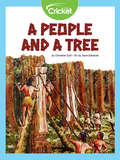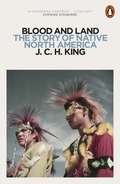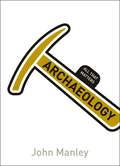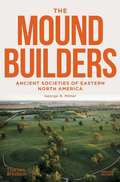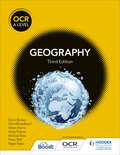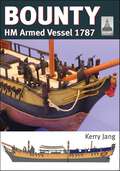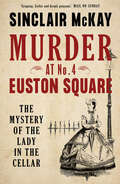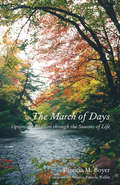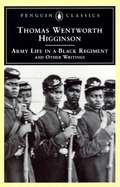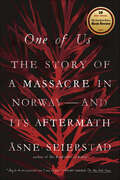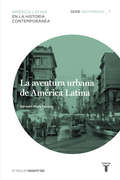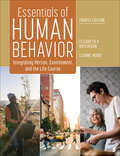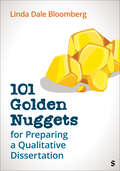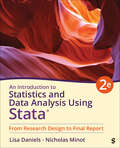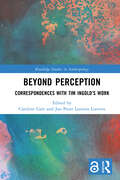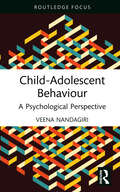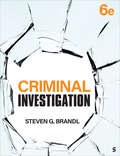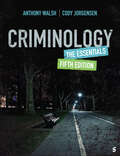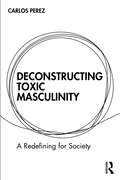- Table View
- List View
A People and a Tree
by Christine GrafNative American tribes from the Northwest Coast learned to use the wood of cedar trees for many of their daily needs. Tribes used recycling to conserve resources hundreds of years ago. Pounding bark until it was fluffy to make diapers and with special thin branches called withes, cedar trees were soaked and used to make rope. What special technique did tribes use to take down big cedar trees?
Blood and Land: The Story of Native North America
by J. C. KingBlood and Land is a dazzling, panoramic account of the history and achievements of Native North Americans, and why they matter today. It is about why no understanding of the wider world is possible without comprehending the original inhabitants of the United States and Canada: Native Americans, First Nations and Arctic peoples.This highly personal book, based on years of travel and first-hand research in North America, introduces a deeply complex story, of myriad identities and determined ethnicities - from the desert Southwest to the high Arctic, from first contact between Europeans and Native Americans to the challenges of Native leadership today. Instead of writing a chronological history, King confronts the reader with the paradoxes, diversity and successes of Native North Americans. Their astonishing ingenuity and supple intelligence enabled, after centuries of suffering both violence and dispossession, a striking level of recovery, optimism and autonomy in the twenty-first century.Beautifully illustrated and filled with arresting and surprising stories, Blood and Land looks well beyond the 'feathers-and-failure' narratives beloved by historians to show us Native North America as it was and is.
Archaeology: All That Matters (All That Matters)
by John Manley- When did archaeology begin?- Who were the first antiquarians in early modern Europe?- How did archaeology free human history from biblical creationism?- How did archaeology become a pseudo-scientific discipline?- Who built the first museum? Leading expert Dr John Manley starts by dealing with the processes and techniques used by archaeologists, in the past and today. He then uses the results of famous archaeological studies both to illustrate the power of archaeology, and to show specifically what archaeology has taught us about Roman, Egyptian, ancient, and surprisingly recent, history. In an exciting final chapter, Manley wonders how archaeology may adapt over time, exploring how the archaeologists of the future may examine our own era.Ideal for students or for general reading, this book delivers a thorough and comprehensive introduction to archaeology. All That Matters about archaeology. All That Matters books are a fast way to get right to the heart of key issues.
The Moundbuilders: Second Edition
by George R. MilnerBrought up to date with the latest research, The Moundbuilders is the definitive visual guide to North America’s eastern region and the societies that forever changed its landscape. Hailed by Bruce D. Smith, curator of North American archaeology at the Smithsonian Institution, as “without question the best available book on the pre-Columbian . . . societies of eastern North America,” this wide-ranging and richly illustrated volume covers the entire prehistory of the Eastern Woodlands and the thousands of earthen mounds that can be found there, built between 3100 BCE and 1600 CE. The second edition of The Moundbuilders has been brought fully up-to-date, with the latest research on the peopling of the Americas, including more coverage of pre-Clovis groups, new material on Native American communities in the thirteenth to sixteenth centuries CE, and new narratives of migration drawn from ancient and modern DNA. Far-reaching and illustrated throughout, this book is the perfect visual guide to the region for students, tourists, archaeologists, and anyone interested in ancient American history.
OCR A Level Geography Third Edition
by David Barker Nigel Yates Andy Palmer Michael Raw Peter Stiff Helen Harris Chris BroadbentHelp your students to develop the geographical skills and knowledge they need to succeed using this new Edition Student book, which includes new case studies and practice questions. Written by our expert author team, the new edition is structured to provide support for A-Level Geography learners of all abilities. The book includes:· Activities and regular review questions to reinforce geographical knowledge and build up core geographical skills· Clear explanations to help students to grapple with tricky geographical concepts and grasp links between topics· Case studies from around the world to vividly demonstrate geographical theory in action· Exciting fieldwork projects that meet the fieldwork and investigation requirementsThis student book is supported by digital resources on our new digital platform Boost, providing a seamless online and offline teaching experience.
OCR A Level Geography Third Edition
by David Barker Nigel Yates Andy Palmer Michael Raw Peter Stiff Helen Harris Chris BroadbentHelp your students to develop the geographical skills and knowledge they need to succeed using this new Edition Student book, which includes new case studies and practice questions. Written by our expert author team, the new edition is structured to provide support for A-Level Geography learners of all abilities. The book includes:· Activities and regular review questions to reinforce geographical knowledge and build up core geographical skills· Clear explanations to help students to grapple with tricky geographical concepts and grasp links between topics· Case studies from around the world to vividly demonstrate geographical theory in action· Exciting fieldwork projects that meet the fieldwork and investigation requirementsThis student book is supported by digital resources on our new digital platform Boost, providing a seamless online and offline teaching experience.
Bounty: HM Armed Vessel 1787 (Shipcraft Ser. #30)
by Kerry JangThe ‘ShipCraft’ series provides in-depth information about building and modifying model kits of famous warships. Previously, these have generally covered plastic and resin models of 20th century subjects but, like the previous volume on Nelson’s Victory, this is a radical departure – not only a period sailing ship but one for which kits are available in many different materials and scales. This requires some changes to the standard approach, but the main features of the series remain constant. Bounty, a merchant vessel purchased to undertake a special mission to the South Pacific, will always be remembered for the drama of the mutiny against Captain Bligh and his epic open-boat voyage that followed. The events inspired many books, and at least three major movies, and make the ship one of the most popular of all ship modelling subjects. Despite the ship’s fame, and the vast range of kits it has inspired, there are question marks over many aspects of the vessel’s fitting and, especially, how it was painted. This volume tackles these questions, reconstructing convincing color schemes for the ship both as a merchant vessel and in naval service. The modelling section reviews the strengths and weaknesses of available kits, lists commercial accessory sets for super-detailing, and provides hints on modifying and improving the basic kit, including the complexities of rigging. This is followed by an extensive photographic gallery of selected high-quality models in a variety of scales, and coverage concludes with a section on research references – books, monographs, large-scale plans and relevant websites. Following the pattern of the series, this book provides an unparalleled level of visual information – paint schemes, models, line drawings and photographs – and is simply the best reference for anyone setting out to model this imposing three-decker.
Murder at No. 4 Euston Square: The Mystery of the Lady in the Cellar
by Sinclair McKayA chilling true crime story of a baffling boarding house murder in Victorian London and the stunning secrets revealed by the investigation.Someone must have known what happened to Matilda Hacker. For someone in that house had killed her. So how could the murderer prove so elusive? Standing four storeys tall in an elegant Bloomsbury terrace, No. 4, Euston Square was a well-kept, respectable boarding house. But beneath this genteel Victorian London veneer lay murderous intrigue. On 9 May 1879, the body of a former resident, Matilda Hacker, was discovered by chance in the coal cellar. The ensuing investigation—led by Inspector Charles Hagen, rising star of the recently formed CID—stripped bare the dark side of Victorian domesticity.In this true-crime story, Sinclair McKay meticulously evaluates the evidence in first-hand sources. His gripping account sheds new light on a mystery that eluded Scotland Yard.Praise for Murder at No. 4 Euston Square“With the gusto of a penny dreadful, Murder at No. 4 Euston Road dodges any stodgy courtroom testimony that can weigh down true crime stories and sticks to the juicy details. It is hard to avoid the comparison with Kate Summerscale’s The Suspicions of Mr Whicher and it has similar historical richness and plot twisting.” —The Spectator (UK)“Sinclair McKay is an accomplished and talented author with a rare skill. . . . True crime fans and history buffs will enjoy this book, coming away with an enthralling true crime story and a new knowledge and understanding of Victorian London.” —Crime Traveller (UK)“Gripping, gothic and deeply poignant.” —The Mail on Sunday (UK)“A meticulously researched book.” —Brian Viner, Daily Mail (UK)
The March of Days: Optimistic Realism through the Seasons of Life
by Patricia M. BoyerAlthough Patricia M. Boyer won a scholarship to McMaster University with the highest mathematics marks in Ontario and graduated at age 19, literature and languages were her specialty. She first worked as a public librarian, next as a secondary school teacher, then as a newspaper editor. A community leader in arts and theatre, Patricia was devoted to human rights action in her local community and around the world, church work, drama, the education of children with disabilities, and music. Each week she wrote a newspaper column inspired by episodes in the world around her, both local and global. She rewarded readers through articles infused with learning from literature, astute sensibility to human psychology, and balanced insights on the tragedies and comedies of life’s passing parade. Patricia Boyer summed up her approach to life as "optimistic realism". This collection of the best of her celebrated columns, organized through the twelve months of the year or "the march of days", includes reflections on seasonal celebrations, changing atmospheres of nature, and calendar milestones in the human cycle. A number of these concise yet poignant writings will move many readers with nostalgia as they evoke the happy events and tragic developments of the Sixties and Seventies. All of them, however, convey the wisdom of a woman whose message of optimistic realism endures like a timeless guide to living a satisfying life in the real world today.
Army Life in a Black Regiment and Other Writings
by Thomas Wentworth HigginsonA stirring account of wartime experiences from the leader of the first regiment of emancipated slavesThomas Wentworth Higginson, a Unitarian minister, was a fervent member of New England's abolitionist movement, an active participant in the Underground Railroad, and part of a group that supplied material aid to John Brown before his ill-fated raid on Harpers Ferry. When the Civil War broke out, Higginson was commissioned as a colonel of the black troops training in the Sea Islands off the coast of the Carolinas. Shaped by American Romanticism and imbued with Higginson's interest in both man and nature, Army Life in a Black Regiment ranges from detailed reports on daily life to a vivid description of the author's near escape from cannon fire, to sketches that conjure up the beauty and mystery of the Sea Islands. This edition of Army Life features as well a selection of Higginson's essays, including 'Nat Turner's Insurrection' and 'Emily Dickinson's Letters. ''Has some claim to be the best written narrative to come from the Union during the Civil War. '- Henry Steele CommagerIntroduction and Notes by R. D. MADISON
One of Us: The Story of a Massacre in Norway—and Its Aftermath
by Åsne SeierstadA New York Times bestseller and the basis for the Netflix film 22 July: “A chilling descent into the mind of mass murderer Anders Breivik.” —Kirkus ReviewsOne of The New York Times Book Review’s Ten Best Books of 2015On July 22, 2011, Anders Behring Breivik detonated a bomb outside the Norwegian prime minister’s office in central Oslo, killing eight people. He then proceeded to a youth camp on the wooded island of Utøya, where he killed sixty-nine more, most of them teenage members of the country’s governing Labour Party. In One of Us, the journalist Åsne Seierstad tells the story of this terrible day and its reverberations. How did Breivik, a gifted child from an affluent neighborhood in Oslo, become Europe’s most reviled terrorist? How did he accomplish an astonishing one-man murder spree? And how did a famously peaceful and prosperous country cope with the slaughter of so many of its young?Delving deep into Breivik’s childhood, Seierstad shows how a hip-hop and graffiti aficionado became a right-wing activist, a successful entrepreneur, and then an Internet game addict and self-styled master warrior who believed he could save Europe from the threat of Islam and multiculturalism. She writes with equal intimacy about Breivik’s victims, tracing their political awakenings, teenage flirtations and hopes, and ill-fated journeys to the island. In the book’s final act, Seierstad describes Breivik’s tumultuous public trial.Lauded in Scandinavia for its literary merit and moral poise, One of Us is at once a psychological study of violent extremism, a dramatic true crime procedural, and a compassionate inquiry into how a privileged society copes with homegrown evil.
La aventura urbana de América Latina. Recorridos_3
by GERMÁN MEJÍA PAVONYEl ochenta por ciento de los latinoamericanos vive hoy en poblaciones de más de 20.000 habitantes. Esta cifra sorprende, pues aceptamos que la mayoría de las localidades de la región apenas sobrepasa el carácter rural. En realidad, la historia del desarrollo urbano del subcontinente ha sido desdeñada por teorías victimistas que la condenan sin remedio al atraso; por ello, resulta paradójico que desde los primeros años del siglo XIX la ciudad se revelara esencial para la construcción de los nuevos Estados nacionales, y que la producción de riquezas, de origen agrario o minero, encontrara en sus urbes la única posibilidad para transformar la sociedad entera. La historia de América Latina es, en este sentido, una aventura de futuro que se construye desde las entrañas de su ya longeva dinámica urbana. Recorridos se propone destacar los ejes comunes a la historia de América Latina en una perspectiva global, libre de visiones nostálgicas y exóticas. La serie analiza desde la independencia hasta la actualidad temas y horizontes que trascienden lo nacional, tanto en el espacio como en el tiempo. Mediante una narrativa accesible y con un enfoque novedoso, identifica elementos de originalidad social y cultural. También reflexiona sobre la potencia y la presencia de América Latina en tiempos de globalización, en los que se ha convertido en destacada protagonista.
Essentials of Human Behavior: Integrating Person, Environment, and the Life Course
by Elizabeth D. Hutchison Leanne WoodEssentials of Human Behavior by Elizabeth D. Hutchison and Leanne Wood integrates the key framework of time, person and environment into a single streamlined text for single or double semester courses. Drawn from Hutchison′s best-selling Dimensions of Human Behavior texts, this Fourth Edition is updated to address equity and inclusion, trauma and resilience, environmental justice, and gender identity and expression. With a multidimensional approach, it helps students connect human behavior theories and research to their applications in social work engagement, assessment, intervention, and evaluation across all levels of practice.
Essentials of Human Behavior: Integrating Person, Environment, and the Life Course
by Elizabeth D. Hutchison Leanne WoodEssentials of Human Behavior by Elizabeth D. Hutchison and Leanne Wood integrates the key framework of time, person and environment into a single streamlined text for single or double semester courses. Drawn from Hutchison′s best-selling Dimensions of Human Behavior texts, this Fourth Edition is updated to address equity and inclusion, trauma and resilience, environmental justice, and gender identity and expression. With a multidimensional approach, it helps students connect human behavior theories and research to their applications in social work engagement, assessment, intervention, and evaluation across all levels of practice.
101 Golden Nuggets for Preparing a Qualitative Dissertation
by Linda Dale BloombergThe 101 "nuggets of understanding" that comprise this book shed light on the required content of a qualitative dissertation. They help readers navigate through the iterative, recursive, and often messy dissertation process, from its inception to a successful completion right from the planning stage, through data collection and analysis, all the way to writing up, presenting, and publishing. Each nugget is posed in the form of a question, as if in conversation with the reader, and will hopefully stimulate critical thinking, reflection, and dialogue. This book is the place to turn to for quick (though not simplified) answers to key questions based on the latest developments in the field of qualitative research. It will motivate doctoral students or prospective doctoral students to seek and consult additional relevant texts and resources in order to delve deeper into the many issues involved in preparing for a qualitative dissertation.
101 Golden Nuggets for Preparing a Qualitative Dissertation
by Linda Dale BloombergThe 101 "nuggets of understanding" that comprise this book shed light on the required content of a qualitative dissertation. They help readers navigate through the iterative, recursive, and often messy dissertation process, from its inception to a successful completion right from the planning stage, through data collection and analysis, all the way to writing up, presenting, and publishing. Each nugget is posed in the form of a question, as if in conversation with the reader, and will hopefully stimulate critical thinking, reflection, and dialogue. This book is the place to turn to for quick (though not simplified) answers to key questions based on the latest developments in the field of qualitative research. It will motivate doctoral students or prospective doctoral students to seek and consult additional relevant texts and resources in order to delve deeper into the many issues involved in preparing for a qualitative dissertation.
An Introduction to Statistics and Data Analysis Using Stata®: From Research Design to Final Report
by Lisa Daniels Nicholas W. MinotAn Introduction to Statistics and Data Analysis Using Stata®: From Research Design to Final Report, Second Edition provides an integrated approach to research methods, statistics and data analysis, and interpretation of results in Stata. Drawing on their combined 25 years of experience teaching statistics and research methods, authors Lisa Daniels and Nicholas Minot frame data analysis within the research process—identifying gaps in the literature, examining the theory, developing research questions, designing a questionnaire or using secondary data, analyzing the data, and writing a research paper—so readers better understand the context of data analysis. Throughout, the text focuses on documenting and communicating results so students can produce a finished report or article by the end of their courses. The Second Edition has been thoroughly updated with all new articles and data—including coverage of ChatGPT, COVID-19 policies, and SAT scores—to demonstrate the relevance of data analysis for students. A new chapter on advanced methods in regression analysis allows instructors to better feature these important techniques. Stata code has been updated to the latest version, and new exercises throughout offer more chances for practice.
An Introduction to Statistics and Data Analysis Using Stata®: From Research Design to Final Report
by Lisa Daniels Nicholas W. MinotAn Introduction to Statistics and Data Analysis Using Stata®: From Research Design to Final Report, Second Edition provides an integrated approach to research methods, statistics and data analysis, and interpretation of results in Stata. Drawing on their combined 25 years of experience teaching statistics and research methods, authors Lisa Daniels and Nicholas Minot frame data analysis within the research process—identifying gaps in the literature, examining the theory, developing research questions, designing a questionnaire or using secondary data, analyzing the data, and writing a research paper—so readers better understand the context of data analysis. Throughout, the text focuses on documenting and communicating results so students can produce a finished report or article by the end of their courses. The Second Edition has been thoroughly updated with all new articles and data—including coverage of ChatGPT, COVID-19 policies, and SAT scores—to demonstrate the relevance of data analysis for students. A new chapter on advanced methods in regression analysis allows instructors to better feature these important techniques. Stata code has been updated to the latest version, and new exercises throughout offer more chances for practice.
Beyond Perception: Correspondences with Tim Ingold's Work (Routledge Studies in Anthropology)
by Gatt, Edited by CarolineThis book showcases the way a range of scholars have engaged with Tim Ingold’s opus since the publication of his ground-breaking The Perception of the Environment in 2000. Ingold’s work has become key for a variety of disciplines ranging from anthropology, archaeology, and human geography to art, architecture, design and studies of material and visual culture. As set out in The Perception of the Environment and subsequent publications, Ingold proposed an understanding of the world that placed sentient, remembering and imagining organisms, or inhabitants, some of them human, at the heart of an extensive field of socio-ecological relations. In this work, Ingold develops broad-ranging analyses of personhood, knowledge and skills, among many other topics. This volume sets out to synthesize critical scholarship drawing on Ingold’s work, to lay out its principles, methods and results, and to demonstrate its contribution to reshaping both contemporary anthropology and wider intellectual terrains. By bringing together chapters from a variety of scholars, all critically furthering Ingold’s proposals, the book advances a paradigm change occurring in various academic disciplines from “fixist” to “emergence” onto/epistemologies.
Child-Adolescent Behaviour: A Psychological Perspective
by Veena NandagiriThis book briefly outlines psychological perspectives of the values, attitudes and behaviour of parents in influencing a child’s personality. The volume discusses important factors and family surroundings that influence a growing child’s development and various techniques that parents and teachers may use to inculcate children’s growth and well-being. Various discipline techniques that parents can use with the child and ways in which they can enhance their child’s creativity and achievement levels are explained. It also discusses the causes, signs and types of learning disabilities, such as dyslexia, dysgraphia, dyscalculia and developmental coordination disorder (dyspraxia), and behaviour disorders like anxiety disorders, conduct disorders, oppositional defiant disorder, attention-deficit hyperactivity disorder (ADHD), aggressive behaviour in children and the speech disorder stuttering. The volume gives an elaborate understanding of the diverse changes, conflicts, emotional turmoil and identity crises that adolescent children go through and how parents and teachers can help them to handle this transitional stage.This book will be of interest to psychologists, parents, students and teachers of psychology and scholars of child development, as well as professionals involved in working with children and adolescents, such as teachers, counsellors, doctors, nurses and social workers.
Criminal Investigation
by Steven G. BrandlCriminal Investigation, Sixth Edition offers a comprehensive and engaging examination of criminal investigation and the vital role criminal evidence plays in the process. Written in a straightforward manner, the text focuses on the five critical areas essential to understanding criminal investigations: background and contextual issues, criminal evidence, legal procedures, evidence collection procedures, and forensic science. In this brand new edition, author Steven G. Brandl goes beyond a simple how-to on investigative procedures, and draws from fascinating modern research, comprehensive cases, and criminal evidence to demonstrate their importance in the real world of criminal justice, providing students with practical insights into the field of criminal investigation.
Criminal Investigation
by Steven G. BrandlCriminal Investigation, Sixth Edition offers a comprehensive and engaging examination of criminal investigation and the vital role criminal evidence plays in the process. Written in a straightforward manner, the text focuses on the five critical areas essential to understanding criminal investigations: background and contextual issues, criminal evidence, legal procedures, evidence collection procedures, and forensic science. In this brand new edition, author Steven G. Brandl goes beyond a simple how-to on investigative procedures, and draws from fascinating modern research, comprehensive cases, and criminal evidence to demonstrate their importance in the real world of criminal justice, providing students with practical insights into the field of criminal investigation.
Criminology: The Essentials
by Anthony Walsh Cody JorgensenIn Criminology: The Essentials, authors Anthony Walsh and Cody Jorgensen introduce students to major theoretical perspectives and criminology topics in a concise, easy-to-read format. This straightforward overview of the major subject areas in criminology thoroughly covers the most up-to-date advances in theory and research, while challenging students to consider the applications of these theories as well as their policy implications. Updates to the Fifth Edition include new topics and developments in criminology, such as racial disparities in arrest rates, insights from the Big Five personality traits, cognitive behavioral therapy, gun violence and policy, and the opioid epidemic. It also offers detailed evaluations of theories to deepen student understanding and foster engaging classroom discussions.
Criminology: The Essentials
by Anthony Walsh Cody JorgensenIn Criminology: The Essentials, authors Anthony Walsh and Cody Jorgensen introduce students to major theoretical perspectives and criminology topics in a concise, easy-to-read format. This straightforward overview of the major subject areas in criminology thoroughly covers the most up-to-date advances in theory and research, while challenging students to consider the applications of these theories as well as their policy implications. Updates to the Fifth Edition include new topics and developments in criminology, such as racial disparities in arrest rates, insights from the Big Five personality traits, cognitive behavioral therapy, gun violence and policy, and the opioid epidemic. It also offers detailed evaluations of theories to deepen student understanding and foster engaging classroom discussions.
Deconstructing Toxic Masculinity: A Redefining for Society
by Carlos PerezThis accessible book explores toxic masculinity, looking at how to define it, and how we can and should challenge its spread. This book draws on Derrida’s deconstruction, using the philosophical lens to deconstruct what toxic masculinity means and to better understand its significance for our society. It focuses on how harmful aspects of masculinity spread, infiltrate, and intoxicate our societies and how existing structures allow aspects of harmful masculinity to become toxic. This book also features discussions and analysis of participants’ lived experiences of masculinities, alongside the author’s reflections. It explores the relevance of toxic masculinity in work environments, politics, relationships, and gender roles and seeks to challenge and mitigate its damages for everyone. Encouraging critical thinking and understanding of healthier ways of being for all, this timely book will be of interest to therapists, counselors, teachers, and practitioners of family studies. It will also be useful reading for students in the fields of psychology, gender studies, sociology, and related fields.
